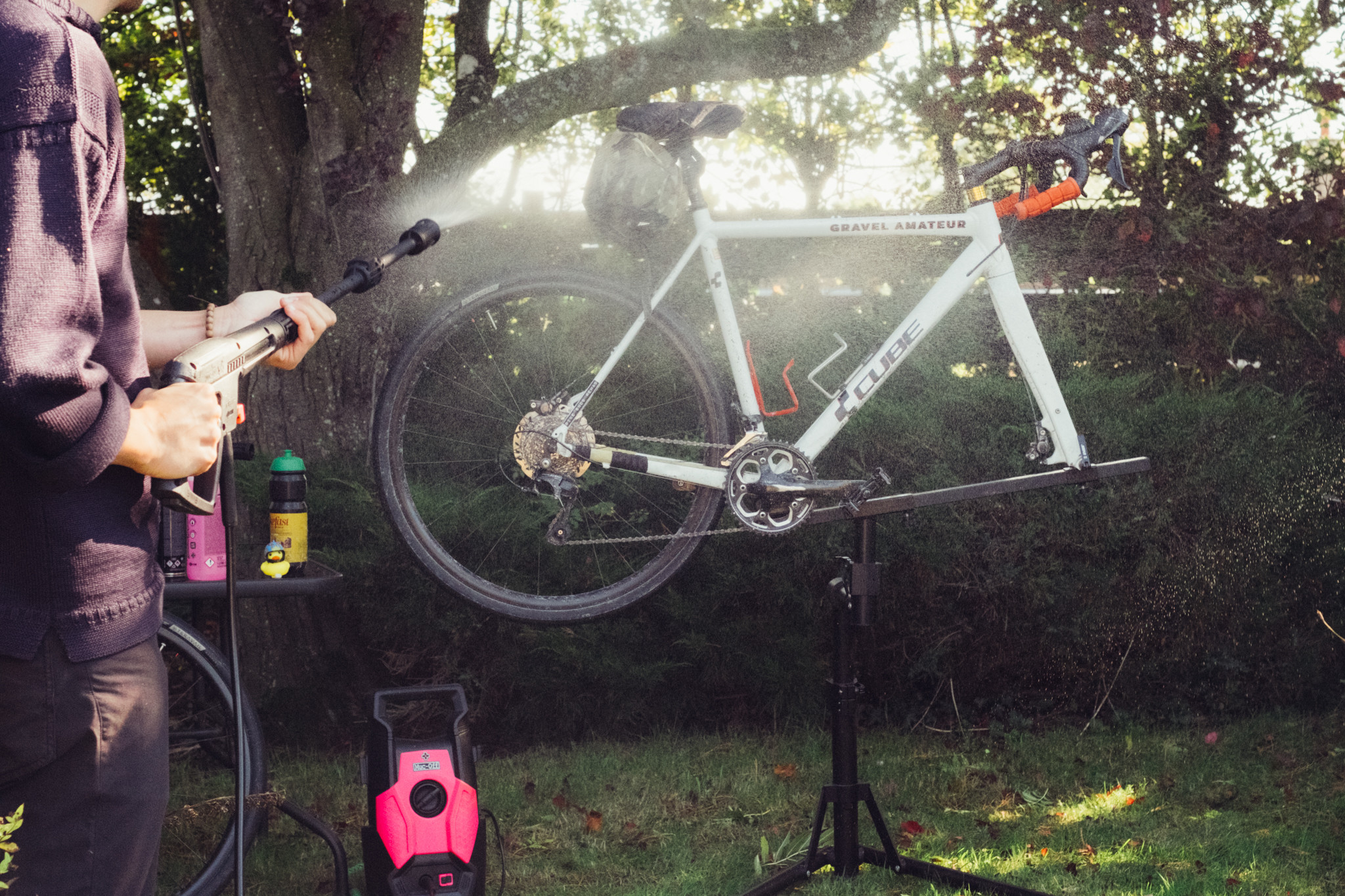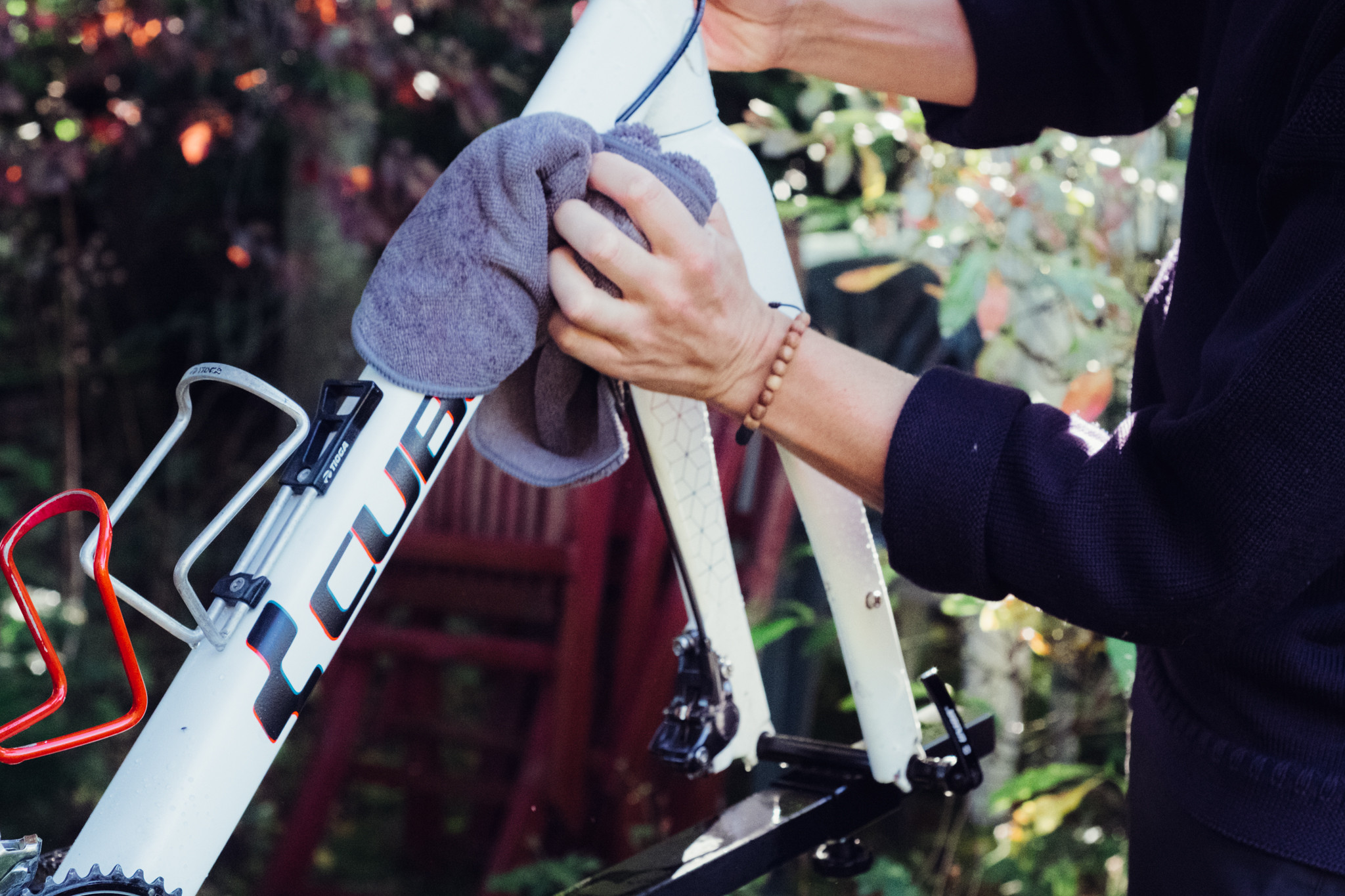Can You Pressure Wash A Bike? Yes, you can pressure wash your bike, but it’s essential to do it safely to avoid damage to delicate components. At usabikers.net, we’re passionate about keeping your ride in top condition, so we’ve put together a comprehensive guide to help you get the job done right. Learn the proper techniques and precautions to ensure your bike stays clean and performs its best, then explore our site for more tips on motorcycle maintenance, biker gear, and motorcycle travel.
1. Understanding the Basics of Pressure Washing Your Bike
Pressure washing your bike can be a quick and effective way to remove dirt and grime. However, it’s not without its risks. Using too much pressure or directing the spray at sensitive areas can lead to damage. Understanding the right techniques and taking necessary precautions is crucial.
1.1. Why Pressure Wash Your Bike?
- Efficiency: Pressure washing is faster than manual cleaning.
- Effectiveness: It removes stubborn dirt and grime easily.
- Convenience: It simplifies the cleaning process.
1.2. Potential Risks of Pressure Washing
- Damage to Bearings: High pressure can force water into bearings, causing rust and premature wear.
- Removal of Grease: Pressure washing can strip away essential grease from moving parts.
- Electronic Component Damage: Sensitive electronics, like those in e-bikes, can be damaged by water ingress.
1.3. Is Pressure Washing Safe for All Bikes?
Pressure washing can be safe for most bikes if done correctly, but it is crucial to assess your specific bike and its components. Vintage bikes or those with delicate parts may be better off being cleaned manually. E-bikes require extra caution due to their electronic components.
2. Essential Tools and Equipment for Pressure Washing
Having the right tools and equipment is critical for a safe and effective pressure washing experience.
2.1. Pressure Washer Selection
- Adjustable Pressure: Choose a pressure washer with adjustable settings.
- Nozzle Types: Opt for a wide-fan nozzle to avoid concentrated pressure.
- PSI Range: Ideal pressure should be between 1200-1600 PSI for bikes.
2.2. Cleaning Agents
- Bike-Specific Cleaners: Use detergents designed for bikes.
- Degreasers: Apply degreaser to the drivetrain to remove grease and grime.
- Avoid Harsh Chemicals: Stay away from strong solvents that can damage paint and components.
2.3. Protective Gear
- Eye Protection: Wear safety glasses to protect against splashes.
- Gloves: Use gloves to protect your hands from chemicals and dirt.
- Apron: Wear an apron to keep your clothes clean and dry.
2.4. Other Useful Tools
- Soft Brushes: Use brushes for scrubbing stubborn dirt.
- Microfiber Cloths: Use to dry and polish your bike.
- Hose: Connect to water source.
- Bucket: Use to prepare your cleaning solution.
3. Step-by-Step Guide to Pressure Washing Your Bike
Follow these steps to safely and effectively pressure wash your bike, ensuring it remains in top condition.
3.1. Preparation
- Remove Accessories: Take off any accessories like GPS units, lights, and bags.
- Protect Sensitive Areas: Cover leather saddles or electronic components with plastic bags.
- Position Your Bike: Place your bike on a stand or lean it against a stable surface.
3.2. Pre-Rinse
- Initial Rinse: Use a wide-fan nozzle to rinse the bike from a safe distance.
- Remove Loose Debris: Focus on removing loose dirt and mud.
- Avoid Direct Spray: Keep the pressure washer moving to avoid concentrating on one spot.
 Pre-rinsing bike
Pre-rinsing bike
3.3. Applying Cleaning Agents
- Apply Degreaser: Apply degreaser to the drivetrain, including the chain, cassette, and derailleurs.
- Apply Soap: Use a bike-specific cleaner on the frame, wheels, and other components.
- Let it Soak: Allow the cleaning agents to sit for a few minutes to loosen dirt.
3.4. Pressure Washing
- Maintain Distance: Keep the pressure washer nozzle at least 2 feet away from the bike.
- Use Wide-Fan Nozzle: Use a wide-fan nozzle to distribute the pressure evenly.
- Avoid Sensitive Areas: Steer clear of bearings, seals, and electronic components.
- Rinse Thoroughly: Rinse all surfaces to remove soap and degreaser residue.
3.5. Drying
- Wipe Down: Use microfiber cloths to dry the frame, wheels, and components.
- Air Dry: Allow the bike to air dry in a well-ventilated area.
- Chain Drying: Dry the chain thoroughly to prevent rust.
 Drying bike with microfiber towels
Drying bike with microfiber towels
3.6. Lubrication and Protection
- Lubricate Chain: Apply chain lube to keep it running smoothly.
- Protect Frame: Use a protective compound to keep the paint fresh.
- Inspect Components: Check for any signs of wear or damage.
3.7. Post-Wash Inspection
- Check Brakes: Ensure brakes are functioning correctly.
- Inspect Tires: Look for cuts or wear.
- Test Ride: Take a short test ride to ensure everything is working properly.
4. Specific Bike Types and Pressure Washing
Different types of bikes require slightly different approaches to pressure washing. Here’s a guide for various bike types:
4.1. Road Bikes
- Lightweight Frames: Be gentle with carbon fiber frames.
- Rim Brakes: Protect braking surfaces from contamination.
- Regular Maintenance: Road bikes often require frequent cleaning due to road grime.
4.2. Mountain Bikes
- Suspension Components: Avoid direct spray on suspension seals.
- Mud and Dirt: Use a slightly higher pressure setting to remove stubborn mud.
- Thorough Cleaning: Pay extra attention to the drivetrain.
4.3. E-Bikes
- Battery Protection: Remove the battery and cover the battery compartment.
- Motor Area: Avoid direct spray near the motor.
- Electrical Connections: Protect all electrical connections to prevent damage.
4.4. Hybrid Bikes
- Versatile Cleaning: Hybrids can handle a moderate pressure wash.
- Component Check: Inspect both road and mountain bike components.
- All-Purpose Cleaner: Use an all-purpose bike cleaner.
4.5. Vintage Bikes
- Gentle Approach: Use a very low-pressure setting or avoid pressure washing altogether.
- Delicate Parts: Many vintage bikes have parts that are delicate.
- Manual Cleaning: Manual cleaning with soft brushes is often the safest option.
5. Common Mistakes to Avoid When Pressure Washing Your Bike
Avoiding these common mistakes will help ensure a safe and effective cleaning process.
5.1. Using Too Much Pressure
- Damage: High pressure can force water into bearings and seals.
- Solution: Use adjustable pressure settings and start with a low setting.
5.2. Directing Spray at Sensitive Areas
- Vulnerable Components: Avoid spraying headsets, bottom brackets, and hubs directly.
- Solution: Use a wide-fan nozzle and maintain a safe distance.
5.3. Neglecting to Remove Accessories
- Potential Damage: Accessories like lights and computers can be damaged.
- Solution: Always remove accessories before washing.
5.4. Using Harsh Chemicals
- Harmful Effects: Strong solvents can damage paint and components.
- Solution: Use bike-specific cleaners and degreasers.
5.5. Skipping Lubrication
- Increased Wear: Lack of lubrication can lead to increased wear and tear.
- Solution: Always lubricate the chain and other moving parts after washing.
5.6. Not Drying the Bike Properly
- Corrosion: Leaving water on the bike can lead to rust and corrosion.
- Solution: Thoroughly dry the bike with microfiber cloths and allow it to air dry.
6. Maintenance Tips for a Long-Lasting Bike
Regular maintenance is key to keeping your bike in top condition. Here are some tips to extend its lifespan.
6.1. Regular Cleaning
- Frequency: Clean your bike after every few rides, especially in wet or dirty conditions.
- Benefits: Prevents buildup of grime and reduces wear.
- Tools: Use brushes, sponges, and bike-specific cleaners.
6.2. Lubrication
- Chain Lubrication: Lubricate the chain regularly to ensure smooth shifting.
- Component Lubrication: Apply grease to moving parts to prevent friction.
- Frequency: Lubricate after cleaning and as needed.
6.3. Checking and Replacing Parts
- Wear and Tear: Regularly inspect parts for wear and tear.
- Replace Components: Replace worn chains, cassettes, and brake pads promptly.
- Safety: Ensures safe and efficient riding.
6.4. Proper Storage
- Dry Environment: Store your bike in a dry place to prevent rust.
- Protection: Use a bike cover to protect it from dust and sunlight.
- Avoid Extremes: Avoid storing in extreme temperatures.
6.5. Professional Servicing
- Annual Check-Up: Take your bike for a professional service annually.
- Expert Inspection: Mechanics can identify and fix potential problems.
- Optimal Performance: Ensures your bike performs at its best.
7. The Environmental Impact of Bike Cleaning
Consider the environmental impact of your cleaning practices and choose eco-friendly options.
7.1. Eco-Friendly Cleaners
- Biodegradable: Use biodegradable bike cleaners.
- Non-Toxic: Opt for non-toxic products that are safe for the environment.
- Reduced Impact: Minimizes harm to ecosystems.
7.2. Water Usage
- Conserve Water: Use water sparingly when cleaning.
- Efficient Methods: Pressure washing can be more water-efficient than using a hose.
- Proper Disposal: Dispose of used water properly to avoid contamination.
7.3. Waste Reduction
- Reusable Materials: Use reusable cloths and sponges.
- Recycle: Recycle empty cleaner bottles and containers.
- Minimize Waste: Reduces environmental footprint.
8. Alternative Cleaning Methods
If you’re not comfortable with pressure washing, here are some alternative cleaning methods that are just as effective.
8.1. Manual Cleaning with a Bucket and Sponge
- Gentle Approach: Ideal for delicate bikes or components.
- Tools: Bucket, sponge, brushes, and bike-specific cleaner.
- Process: Mix cleaner with water, scrub the bike, and rinse with a hose.
8.2. Using Bike Cleaning Wipes
- Convenient: Great for quick cleanups after a ride.
- Portability: Easy to carry in your bike bag.
- Application: Wipe down the frame, wheels, and components.
8.3. Waterless Bike Cleaners
- Eco-Friendly: Uses minimal water and biodegradable formulas.
- Application: Spray on, wipe off.
- Effective: Removes dirt and grime without rinsing.
9. Troubleshooting Common Cleaning Issues
Even with the best techniques, you might encounter some issues. Here’s how to troubleshoot them.
9.1. Stubborn Grime
- Problem: Dirt and grime that won’t come off easily.
- Solution: Use a stronger degreaser, let it soak longer, and scrub with a stiff brush.
9.2. Rust Formation
- Problem: Rust appearing on components after cleaning.
- Solution: Dry the bike thoroughly, apply rust inhibitors, and lubricate regularly.
9.3. Squeaky Brakes
- Problem: Brakes squeaking after cleaning.
- Solution: Clean brake pads and rotors with isopropyl alcohol.
9.4. Chain Issues
- Problem: Chain skipping or not shifting smoothly.
- Solution: Clean and lubricate the chain, check for worn links, and adjust derailleurs.
10. The Biker Community and Bike Maintenance
The biker community is all about sharing knowledge and helping each other out. Here’s how you can get involved.
10.1. Online Forums and Groups
- Usabikers.net: Join usabikers.net to connect with other bikers and share maintenance tips.
- Expert Advice: Get answers to your questions from experienced riders.
- Community Support: Find support and encouragement for your maintenance efforts.
10.2. Local Bike Shops
- Professional Advice: Consult with local bike shop mechanics for expert advice.
- Workshops: Attend workshops to learn new maintenance skills.
- Community Events: Participate in local biking events and meet fellow riders.
10.3. Group Rides and Maintenance Days
- Learn Together: Organize group rides with maintenance stops to share tips and tricks.
- Help Each Other: Assist fellow riders with cleaning and maintenance tasks.
- Build Camaraderie: Strengthen the biker community through shared activities.
10.4. Share Your Experiences
- Document Your Process: Take photos and videos of your cleaning and maintenance routines.
- Write Blog Posts: Share your experiences and tips on platforms like usabikers.net.
- Engage with Others: Respond to questions and comments from fellow bikers.
By following these guidelines, you can safely and effectively pressure wash your bike, keeping it clean and well-maintained for years to come. Remember to always prioritize safety and use the right tools and techniques.
FAQ: Pressure Washing Your Bike
1. Can you pressure wash a bike?
Yes, you can pressure wash a bike if you do it carefully and follow specific guidelines to protect sensitive components. The key is to use a low-pressure setting and avoid spraying directly at bearings, seals, and electrical parts.
2. What PSI is safe for pressure washing a bike?
A pressure between 1200 and 1600 PSI is generally considered safe for pressure washing a bike. Using a wide-fan nozzle can also help distribute the pressure more evenly.
3. How often should I pressure wash my bike?
How often you pressure wash your bike depends on how often you ride and the conditions you ride in. For regular riders, cleaning every few weeks is a good practice. If you ride in muddy or dirty conditions, clean your bike after each ride to prevent grime buildup.
4. Can pressure washing damage my bike’s bearings?
Yes, pressure washing can damage your bike’s bearings if you spray directly at them with high pressure. Water can penetrate the seals and cause rust and premature wear. Always avoid spraying directly at the headset, bottom bracket, and hubs.
5. Is it safe to pressure wash an e-bike?
Pressure washing an e-bike requires extra caution due to its electrical components. Remove the battery and cover the battery compartment. Avoid spraying water near the motor and electrical connections to prevent damage.
6. What type of cleaner should I use when pressure washing my bike?
Use a bike-specific cleaner that is designed to remove dirt and grime without damaging the paint or components. Avoid using harsh chemicals or strong solvents, as these can cause damage.
7. How do I protect my bike’s leather saddle during pressure washing?
To protect your bike’s leather saddle during pressure washing, cover it with a plastic bag or a protective cover. This will prevent it from absorbing water and becoming damaged.
8. What should I do after pressure washing my bike?
After pressure washing your bike, dry it thoroughly with microfiber cloths and allow it to air dry. Lubricate the chain and other moving parts to prevent rust and ensure smooth operation. Inspect the brakes, tires, and other components for any signs of wear or damage.
9. Can I use a car pressure washer on my bike?
While you can use a car pressure washer on your bike, be extremely careful and use the lowest pressure setting. Car pressure washers typically have higher PSI levels than what is safe for bikes, so maintaining a safe distance and using a wide-fan nozzle is crucial.
10. Where can I find more tips on bike maintenance and connect with other bikers?
You can find more tips on bike maintenance and connect with other bikers by visiting usabikers.net. Our website offers a wealth of information on bike care, maintenance, and community events. Join our community to share your experiences and learn from fellow riders.
At usabikers.net, we’re dedicated to providing you with the best information and resources for all your biking needs. From maintenance tips to community events, we’ve got you covered.
Ready to take your bike maintenance to the next level? Visit usabikers.net today to explore our articles, join our forums, and discover everything you need to enhance your biking experience. Connect with a passionate community, find expert advice, and stay updated on the latest trends in the biker world. Your next adventure starts here!
Address: 801 Sturgis Main St, Sturgis, SD 57785, United States
Phone: +1 (605) 347-2000
Website: usabikers.net

